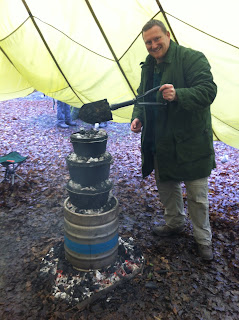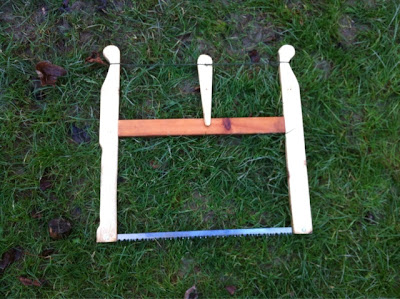One of the key principles of Bushcraft, in my opinion, is
the ability to light a fire. The truth is there are hundreds of ways to light a
fire, some are really ingenious and simple, like a lighter or matches. Some are
scientific like using potassium permanganate and glycerin or a ferro rod. Then
there are primitive techniques like the hand drill or bamboo thong. But for me
the benchmark is the ability to light a fire using the bow drill method.
Now I’ve been able to light fires using other methods for
years now, my personal favourite is vaseline in cotton wool and sparks from a
ferro rod, a very quick method to get a flame. Others have included the use of
cramp ball fungus and a ferro rod and a feather stick. But one method has
eluded me since I really became serious about Bushcraft, and that’s the bow
drill. Now I’ve read up on this and there seems to be a variety of techniques
and woods that you should use. Which in its self can be quite confusing and
daunting. Not being a big fan of reading to learn, I’d rather learn through
experience, I was lucky enough to do a course with Paul Kirtley a month or so
ago where he produced a bow drill set whilst we were on a walk in what only can
be described as biblical weather. Well as you would expect he made it look devilishly
simple, so simple in fact that he even managed to get me to make an ember and
light some tinder, with a little help. In fact I’d never considered that it
could be a 2 person job, so much easier!
But since then it’s been bugging me that I couldn’t quite
manage it on my own. No reflection on Paul by the way, in fact if it wasn’t for
what he taught me, I still wouldn’t have got to where I am today. So now armed
with some practical techniques, a better understanding of what I’m doing and
some of the factors that held me back, I set off to achieve a solo ember.
Now one thing I’ve learnt in not just Bushcraft, but many
facets of life, is that you have to have the common sense to adapt to your
environment and physical (dis)abilites. It’s no secret that I’m a little on the
heavy side but add in asthmatic and generally broken from over 30 years of
pushing my body beyond normal limits and breaking points, I have a few physical
restrictions. So taking what I’ve learnt from Paul, the advice from other great
Bushcrafters like Kepis from BCUK, the long Jubilee Bank Holiday was going to
be the weekend I’d master the bow drill.
Now some would say seasoning your hearth beforehand is
cheating, but I like to call it preparation. Having cut up a well seasoned
poplar for charcoal burning, I kept a piece to one side and planked it to use
for future bow drilling. Next piece of the puzzle was the string. String is
something that I am not short of, so a bit of cord was stashed in my pocket. As
for the bow, I’ve been playing with the bow drill for years and have had the
same bow from day one. I know it’s easy enough to find a bit of wood to suit,
but why cut more wood than you need to. With that ethos in mind, I scavenged a
length of hazel from the spoils of some bad pollarding by the electric company
under some power lines that run through a local wood to me. My set was complete
and a day in the woods began.
 |
| my first set in the woods |
I shaped my drill, carved a depression into my hearth and
away I went. I made the drill longer to suit my physical impairment (a big fat
belly) and things were going great. Then the string started to slip on my drill
and cut through itself. Quickly swapped it for a new piece of paracord. Well it
was obviously good as it started slipping too and cut the drill in half.
A minor set back, I thought, and grabbed another stick,
trimmed and shaped it and off we went again. Sadly the new bit of string didn't
last either, so home I came.
Discussing it with fellow Bushcrafters, Kepis made a couple
of good observations. He usually cuts his drill to about the thickness of his
thumb and also the wood looks a bit ‘punky’. Agreeing with him, I set out to
cut myself a piece of hazel suitable for the job. As I didn’t have his thumb to
hand, I went for something a little thicker than my own and matched the drill
Paul had given me from our course.
Now tooled up and resorting to backyard bushcraft, as the
weather wasn’t playing ball, I had another go. Still no success, so now to fall
back onto common sense.
- Stop,
look at what is actually happening
- Think,
why is it happening
- Reflect, look back at what you were taught
- Change
what you’re doing
I realised that my drill was polishing up and not making
good contact with the hearth, so replaced the cord with a bit of 550 paracord,
reshaped the drill, started a new hearth hole and made a new bearing block (had
worn through the other). So pretty much started from scratch and not being able
to spend too much time at it, I gave it one final blast and what do you know,
it worked.
 |
| My first solo ember |
So what have I learnt from this? Well, a good cord makes a
difference, also getting the tension right makes life a lot easier, it didn't
need to be as taut as I thought. For me, the drill needed to be longer than
usual and a bit fatter than my thumb, also finding a rhythm that allows me to
breathe made sure I could keep going at the vital time. Being out of breath
also meant that was there was enough of a pause once the ember was smoking on
its own to build up. So now I feel I can pop a tick against this one, next,
well let's see if I can get the time of creating it down to less than three
days.
 |
| My successful bow drill set |
Special mentions to Paul Kirtley for showing me how
Kepis for reminding me

















